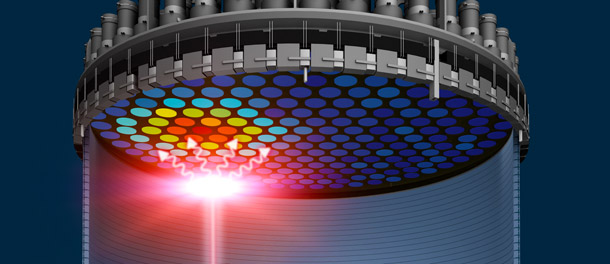|





|
|





|
|
|
ResearchI am interested in understanding the constituents of the universe and the principles that govern their interactions at the most fundamental level. Standard Model (SM) of the particle physics describes the universe in terms of quarks and leptons (spin=1/2), force carriers (photon, $W/Z$ and gluons, spin=1) and Higgs boson, a scalar particle. Higgs boson plays a special role in this model. Quarks and leptons acquire mass through their interaction with Higgs field. All these particles are point particles i.e. they have no internal structure. SM has been tested extensively and has proved to be a very successful "theory of almost everything visible" up to the energies accessible in the laboratories. Discovery of Higgs boson, the last missing piece of the SM, was announced on July 4, 2012 by two experiments working at the Large Hadron Collider at CERN, a European particle physics laboratory, Geneva Switzerland. LHC collides two proton beams. The center of mass energy was 7 TeV in 2010, increased to 8 TeV in 2012 and further increased to 13 TeV in 2015. I am member of the CMS collaboration. The properties of this newly discovered particles, to the extend we can tell given current precision of the measurements, are consisted with SM predictions. Regardless of the exceptional success of the SM, we know it is incomplete. It leaves too many questions unanswered. For example it has no candidate for dark matter (DM) particles whose existence has been postulated to explain many cosmological and astrophysical observations. DM is about 80% of the matter content of the universe but has never been observed in the laboratory. There are several extensions of the SM that predict new weakly-interacting massive particles (WIMPs) that could fit Dark Matter properties. One such model is SuperSymmetry. Current effort at LHC is dominated by search for signatures of these extensions of SM. In addition, the properties of Higgs boson are measured more precisely to detect any deviations from SM based expectations. Search for Super Symmetry and Dark MatterAt CMS, I searched for new particles predicted by SuperSymmetry, most theoretically studied and experimentally tested extension of SM. It postulates a new space-time symmetry. Supersymmetry predicts that each of the particles in the Standard Model has a partner with a spin that differs by half of a unit that is for every fermion in SM, there exist a boson which has the properties as the SM particle except spin and for every boson in SM there exists a new fermion. Clearly, SuperSymmetry is a broken symmetry and these postulated particles are more massive than the SM particles. However, these particles are expected to be light enough to be produced at LHC. In many versions, the lightest supersymmetric particle is predicted to be stable and electrically neutral and to interact weakly with the particles of the Standard Model. Such a particles is a natural candidate for dark matter particle.
In addition, I also did a generic search for DM particles possibly produced in pp collisions but need not be incorporated in Super Symmetry framework.
I also searched for signatures of Large Extra Dimension. LED models suggest that our universe is not limited to ordinary three space dimensions and one time dimension but there are additional space dimensions. These models are proposed to explain the smallness of gravity interaction strength compared to strength of other forces, namely strong and electro-weak force. Gravity is 10-36 times weaker than the strong force. Needless to add that so far no deviation from SM has been observed but the search continues. Discovery of the top quarkI am also member of CDF collaboration at Fermi National Accelerator Laboratory IL which discovered the top quark in 1995. The top quark is much more massive than expected, about 175 times heavier than a proton. For comparison, a gold atom has mass equivalent to about mass of 197 protons. One should note that the top quark is a fundamental (point) particle where as gold atom consists of 79 protons and on average 118 neutrons. Both protons and neutrons are made of mainly up and down quarks. Discovery of top quark completed the quark and lepton sectors of the SM. High mass of top quark is intriguing and its better understanding may guide us to better model of fundemental particles. At CDF, I searched for quark sub-structure (are they really fundamental particles?) by measuring the quark-quark interaction rate. I also searched for new particles decaying into a pair of hadronic jets. A hadronic jet is a signature of a quark or a gluon. Such particles are predicted by many extensions of SM. Direct Detection of Dark Matter ParticleIn June 2018, I joined LUX-Zeppelin (LZ), a two-phase Xe experiment located in Sanford Underground Research Facility at 4850 level in former Homestake Gold Mine, Lead South Dakota. The detector is under construction and is expected to start taking data in 2020. This experiment searches for dark matter particles (WIMPS) through their interaction with ordinary matter, in particular Xenon nuclei. During WIMP-nucleus collision a very small amount of energy is transferred to the Xe nucleus. This energy is released in form of prompt light (S1) and free electrons. These free electrons travel through external electric field, interact with Xe gas above the liquid Xe and produce additional light (S2), delayed with respect to S1 signal. The WIMP-nucleus interactions are normally identified by requiring both S1 and S2 signals. Detection of dark matter particle and measurement of its properties will be a great step in building a more complete model of particles and their interactions. Low energy electrons-electron interaction can mimic the DM-Xe collision signal. I am working on determining the detector response to electrons using methane where one of the hydrogen atom has been replaced by a tritium atom. Tritium decay produces electron which have energy similar in magnitude to one produced by WIMP-Xe scattering, thus these electrons provide a very good estimate of electron-recoil energy observed in the detector in the region of interest. Research Program Management at DOE/HEPI was physicist at the Office of High Energy Physics in U. S. Department of Energy primarily working in Cosmic Frontier from August 2013 to August 2017. Cosmic Frontier portfolio includes dark energy studies, direct and direct and indirect dark matter searches, study of cosmic microwave background radiations and search for new phenomenon by studying cosmic rays and gamma rays. I was program manager of two dark matter experiments 1) Axion Dark Matter experiment (ADMX), an axion search experiment using microwave cavities in strong magnetic field at ultra cold temperature (100 mK), 2) PICO-60, an experiment at SNOLAB, Sudbury, Canada which identifies WIMP-nucleon interactions by detecting the bubbles formed in a super-heated C3F8. This experiment has unique sensitivity to the spin-dependent WIMP-nucleon interactions. In addition, I managed DM R&D program and was HEP contact person of DM Cosmic Vision group. This group was setup to enable two-way communication between office of High Energy Physics and the community working on the dark matter searches. I was program manager of SPT-3G experiment, a cosmic microwave background experiment situated at South Pole. I was also program manager of the Fermi-Gamma Ray Space Telescope, Pierre Auger Observatory near Malargue, Argentina, High Altitude Water Cerenkov (HAWC) located on the flanks of the Sierra Negra volcano near Puebla, Mexico and Very Energetic Radiation Imaging Telescope Array System (VERITAS) located at Fred Lawrence Whipple S Observatory in southern Arizona. FGST, PAO, HAWC are VERITAS are international collaborations. NASA is partner for FGST and NSF is partner for PAO, HAWC and VERITAS. There were regular meetings between officials of the funding agencies and project managers to monitor the operations of these experiments where I represented U. S. Department of Energy. I also managed many university grants covering research using pp collisions (CMS and ATLAS at LHC), e+e- interactions, neutrino properties, precision muon measurements, dark energy studies, dark matter searches, study of cosmic and gamma rays and theoretical particle physics. In addition, I worked in managing CMS and ATLAS detector operations. TeachingPhysics 174: Physics Laboratory IntroductionFall 2018: Physics 174 is an introductory physics laboratory course. This course is designed to teach a few basic ideas and tools which students need for later labs, in particular understanding experimental errors, use of computer spreadsheets to analyze, plot and fit data, and working with simple electrical circuits and use of electrical measuring equipment. This course is intended for, but not limited to, students who are interested in majoring in Physics. Physics 107: Light, Perception, Photography & Visual Phenomena LaboratorySpring 2019, Spring 2020, Spring 2021, Spring 2022: Physics 107 is a laboratory to accompany PHYS106. Laboratory experiments include geometrical optics (lenses, cameras, eye), optical instruments (telescope, binoculars), photography, perception, color phenomena, and wave phenomena. Physics 275: Experimental Physics ISpring 2019, Spring 2020, Fall 2021. Fall 2022: Physics 275, introductory Physics lab course, is intended for physics majors and also for science and engineering students who desire a more rigorous introduction to experimental science. Experiments are mainly chosen in the general area of mechanics. Focus of the course is to understand the sources of uncertainties in experimental measurements, and how to determine their magniutude, and how to communicate the measurements and the derived results in presense of these uncertainties. |